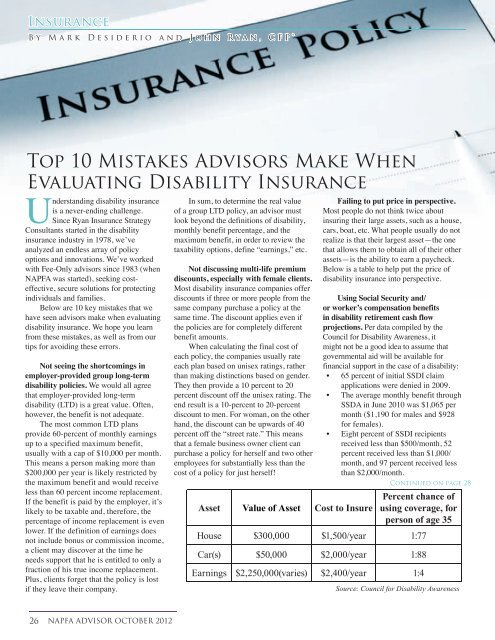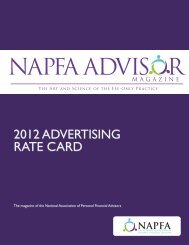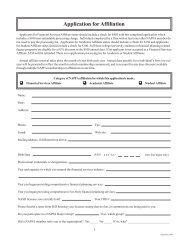Q&A with Kelli Hueler: - Napfa
Q&A with Kelli Hueler: - Napfa
Q&A with Kelli Hueler: - Napfa
Create successful ePaper yourself
Turn your PDF publications into a flip-book with our unique Google optimized e-Paper software.
insurance<br />
By Mark desiderio and John ryan, cfp®<br />
Top 10 Mistakes advisors Make When<br />
Evaluating disability insurance<br />
Understanding disability insurance<br />
is a never-ending challenge.<br />
Since Ryan Insurance Strategy<br />
Consultants started in the disability<br />
insurance industry in 1978, we’ve<br />
analyzed an endless array of policy<br />
options and innovations. We’ve worked<br />
<strong>with</strong> Fee-Only advisors since 1983 (when<br />
NAPFA was started), seeking costeffective,<br />
secure solutions for protecting<br />
individuals and families.<br />
Below are 10 key mistakes that we<br />
have seen advisors make when evaluating<br />
disability insurance. We hope you learn<br />
from these mistakes, as well as from our<br />
tips for avoiding these errors.<br />
Not seeing the shortcomings in<br />
employer-provided group long-term<br />
disability policies. We would all agree<br />
that employer-provided long-term<br />
disability (LTD) is a great value. Often,<br />
however, the benefit is not adequate.<br />
The most common LTD plans<br />
provide 60-percent of monthly earnings<br />
up to a specified maximum benefit,<br />
usually <strong>with</strong> a cap of $10,000 per month.<br />
This means a person making more than<br />
$200,000 per year is likely restricted by<br />
the maximum benefit and would receive<br />
less than 60 percent income replacement.<br />
If the benefit is paid by the employer, it’s<br />
likely to be taxable and, therefore, the<br />
percentage of income replacement is even<br />
lower. If the definition of earnings does<br />
not include bonus or commission income,<br />
a client may discover at the time he<br />
needs support that he is entitled to only a<br />
fraction of his true income replacement.<br />
Plus, clients forget that the policy is lost<br />
if they leave their company.<br />
In sum, to determine the real value<br />
of a group LTD policy, an advisor must<br />
look beyond the definitions of disability,<br />
monthly benefit percentage, and the<br />
maximum benefit, in order to review the<br />
taxability options, define “earnings,” etc.<br />
Not discussing multi-life premium<br />
discounts, especially <strong>with</strong> female clients.<br />
Most disability insurance companies offer<br />
discounts if three or more people from the<br />
same company purchase a policy at the<br />
same time. The discount applies even if<br />
the policies are for completely different<br />
benefit amounts.<br />
When calculating the final cost of<br />
each policy, the companies usually rate<br />
each plan based on unisex ratings, rather<br />
than making distinctions based on gender.<br />
They then provide a 10 percent to 20<br />
percent discount off the unisex rating. The<br />
end result is a 10-percent to 20-percent<br />
discount to men. For woman, on the other<br />
hand, the discount can be upwards of 40<br />
percent off the “street rate.” This means<br />
that a female business owner client can<br />
purchase a policy for herself and two other<br />
employees for substantially less than the<br />
cost of a policy for just herself!<br />
Asset Value of Asset Cost to Insure<br />
Failing to put price in perspective.<br />
Most people do not think twice about<br />
insuring their large assets, such as a house,<br />
cars, boat, etc. What people usually do not<br />
realize is that their largest asset—the one<br />
that allows them to obtain all of their other<br />
assets—is the ability to earn a paycheck.<br />
Below is a table to help put the price of<br />
disability insurance into perspective.<br />
Using Social Security and/<br />
or worker’s compensation benefits<br />
in disability retirement cash flow<br />
projections. Per data compiled by the<br />
Council for Disability Awareness, it<br />
might not be a good idea to assume that<br />
governmental aid will be available for<br />
financial support in the case of a disability:<br />
• 65 percent of initial SSDI claim<br />
applications were denied in 2009.<br />
• The average monthly benefit through<br />
SSDA in June 2010 was $1,065 per<br />
month ($1,190 for males and $928<br />
for females).<br />
• Eight percent of SSDI recipients<br />
received less than $500/month, 52<br />
percent received less than $1,000/<br />
month, and 97 percent received less<br />
than $2,000/month.<br />
continued on page 28<br />
Percent chance of<br />
using coverage, for<br />
person of age 35<br />
House $300,000 $1,500/year 1:77<br />
Car(s) $50,000 $2,000/year 1:88<br />
Earnings $2,250,000(varies) $2,400/year 1:4<br />
Source: Council for Disability Awareness<br />
26<br />
<strong>Napfa</strong> advisor ocToBEr 2012







